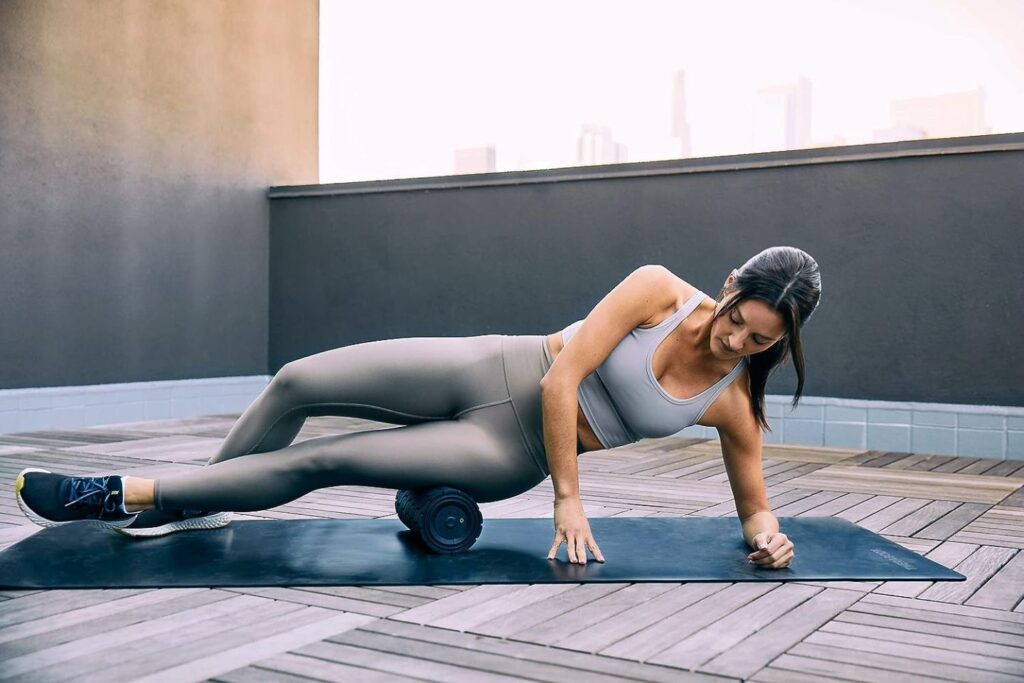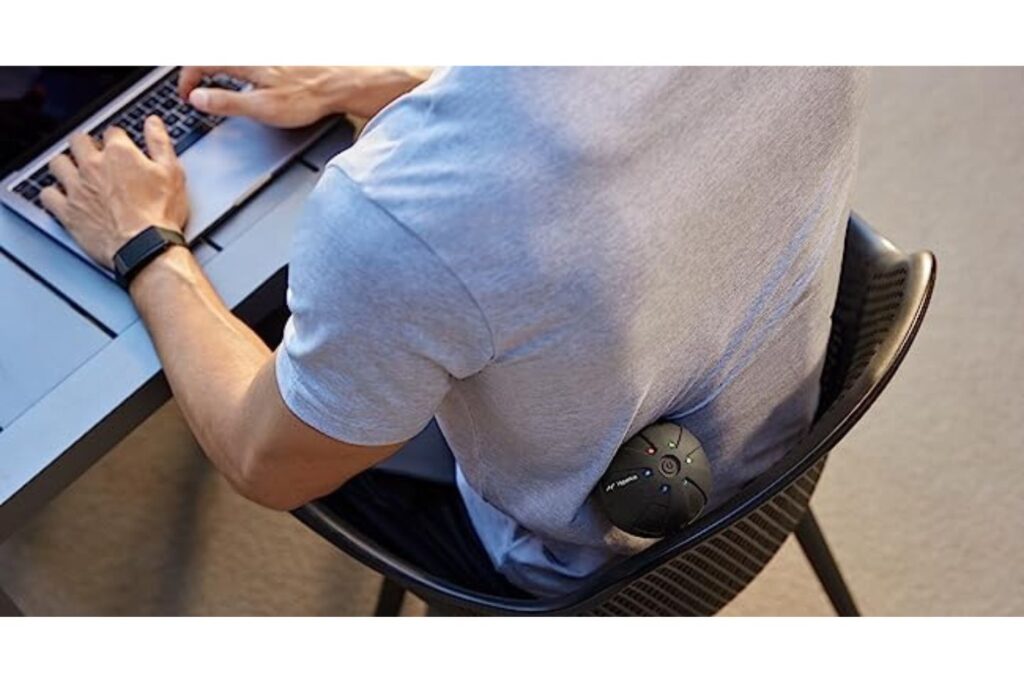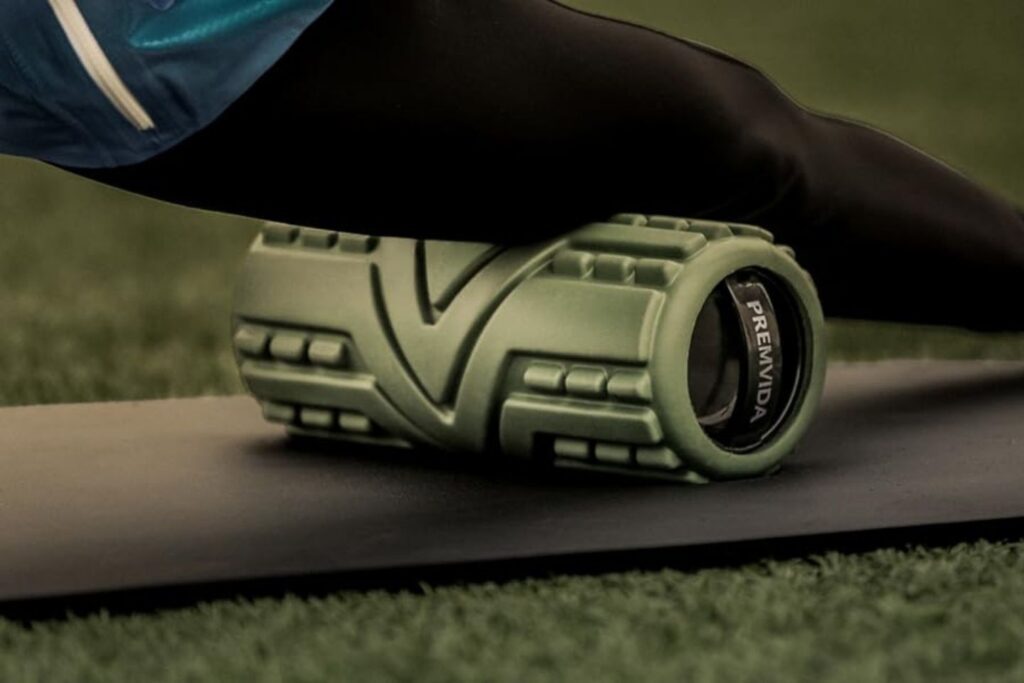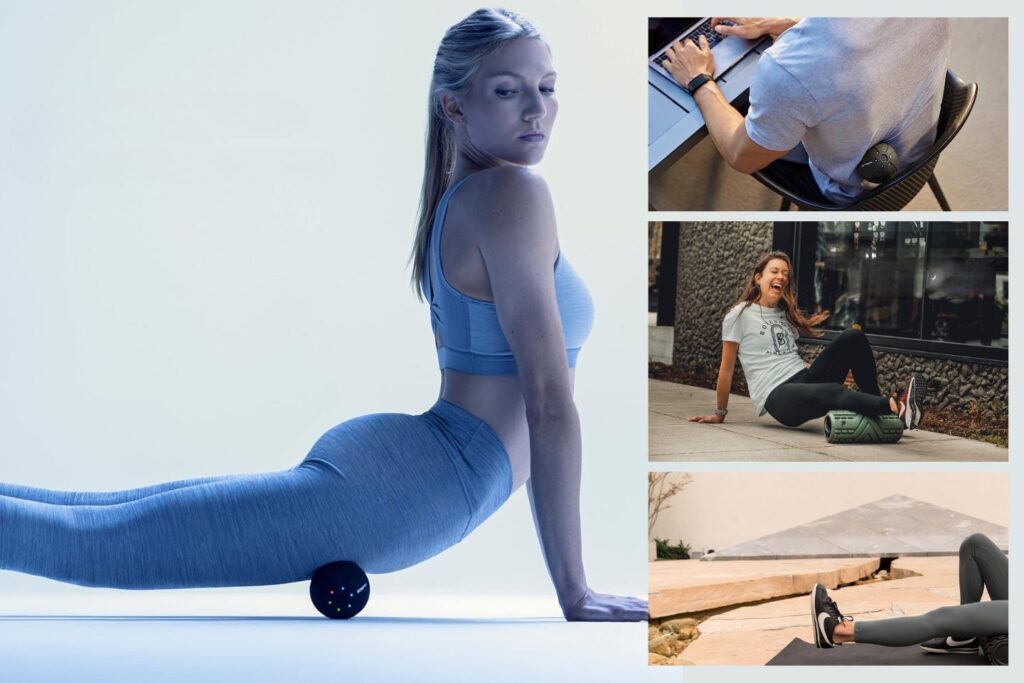Vibration therapy utilizes a vibrating platform to prompt quick muscle contractions throughout the body. It’s thought to boost circulation, strengthen muscles, and trigger tissue repair, potentially expediting injury recovery by diminishing inflammation and hastening the healing process.
A foam roller is a handy tool, like a cylindrical cushion made of foam, used for self-massage and muscle release. It’s great for gently kneading out tight spots and relieving muscle tension. Incorporating foam rolling into your injury recovery routine can be really helpful, as it can improve blood flow, reduce inflammation, and make you feel more flexible, which all contribute to a faster healing process. Now imagine these two being in one tool—a vibrating foam roller.
Now, that’s some good stuff. These devices build upon the traditional foam roller by adding vibration technology, which purports to enhance the benefits of foam rolling by increasing blood flow and reducing muscle tightness more effectively. As you weigh your options for recovery tools, it’s crucial to consider whether the extra features justify the additional investment.
Benefits of Vibrating Foam Rollers
When you consider integrating a vibrating foam roller into your workout routine, the potential benefits for muscle recovery and flexibility are significant. These technologically enhanced rollers provide a more efficient way to prepare your muscles for exercise and help them recover afterward.
Enhanced Muscle Recovery
Vibrating foam rollers may help speed up your muscle recovery process after workouts. Vibrational therapy works to reduce muscle soreness and can decrease the time it takes for muscles to return to normal function. A study mentioned by Kingsfield Fitness claimed that foam rolling with vibration is twice as effective as traditional methods.
Improved Flexibility and Range of Motion
You may experience up to a 40% improvement in flexibility and range of motion when using a vibrating foam roller compared to an 18% improvement with the non-vibrating kind. This is due to the roller’s ability to relax tight muscles and fascia, which in turn supports greater movement and less risk of injury.
Increased Blood Circulation
Optimal blood flow is crucial for muscle health and recovery. With the additional vibration, these foam rollers are designed to increase circulation, delivering more oxygen and nutrients to your muscles. This enhanced blood flow can lead to quicker recovery and better overall muscular health.
How Vibrating Foam Rollers Work


Vibrating foam rollers are an evolution in self-massage tools, enhancing the traditional foam roller experience with the addition of vibration to help improve muscle recovery and flexibility.
Vibration Technology Explained
Vibrating foam rollers incorporate battery-powered motors that deliver pulsating pressure into the muscles. These motors create varying levels of vibration, often adjustable, intended to increase circulation, reduce muscle soreness, and enhance the rolling experience. Studies suggest that the added vibration function can more effectively loosen tight muscles and reduce delayed onset muscle soreness (DOMS) compared to non-vibrating rollers.
Comparing Traditional and Vibrating Foam Rollers
- Traditional Rollers: Primarily rely on the pressure you apply to target muscle groups through manual rolling.
- Pros: Offer a range of firmness and softness suitable for different preferences.
- Cons: It may be less effective at increasing the range of motion and blood flow.
- Vibrating Rollers:
- Pros: Can increase range of motion, blood flow, and flexibility significantly more than traditional rollers. They may also shorten recovery time.
- Cons: Typically have a higher price point and more limited range in firmness.
By employing a combination of pressure and vibration, vibrating foam rollers aim to provide a deeper, more effective muscle release.
Types of Vibrating Foam Rollers


Exploring the various vibrating foam rollers, you will find options that suit different needs based on size, density, and convenience. Understanding these choices is crucial to picking one that aligns with your fitness and recovery routine.
Various Sizes and Densities
Vibrating foam rollers come in a spectrum of sizes and densities for targeted or broad muscle treatment. Compact rollers are better for a focused massage on areas like your arms or calves. Longer rollers, as the Therabody Wave Roller Smart Foam Roller offers, provide a broader surface that’s ideal for your back or legs.
When it comes to density, soft rollers can be gentle on your muscles, while firm options like the ones from Hyperice can offer a deeper, more intense experience. Personal preference and pain tolerance will guide your choice.
Portable and Rechargeable Options
In an effort to aid in your recovery routine no matter where you are, you’ll discover rollers that are designed with portability in mind. Rechargeable rollers like the Premvida 3-Speed Vibrating Foam Roller provide the convenience of use away from power sources, which is perfect for athletes on the go. These oftentimes come with varying charging capacities, making it imperative to find one that can maintain power for your required duration.
To keep these tools efficient and ready at a moment’s notice, look for options that have a battery level indicator to remind you when it’s time to recharge. Some rollers may also provide a carrying case or built-in handles for even easier transportation.
Usage Recommendations
Vibrating foam rollers can be advantageous in various scenarios and incorporating them into your routine could lead to significant benefits. Here is how you can optimize their use.
Ideal Scenarios for Use
- Post-Exercise Recovery: After a strenuous workout session, a vibrating foam roller can help alleviate muscle soreness and hasten recovery.
- Pre-Exercise Warm-Up: Utilizing a vibrating foam roller before a workout can improve circulation and enhance muscle flexibility, preparing your body for physical activity.
Suggested Frequencies and Durations
- Routine Maintenance: Aim for 3 to 5 times per week, spending about 5 to 10 minutes per session to help maintain muscle elasticity and reduce stiffness.
- Targeted Recovery: If addressing specific sore spots or injuries, use the roller for brief, focused 30-second rolls over each muscle group, adjusting as necessary for your comfort and recovery needs.
Scientific Research and Evidence


When you’re considering the purchase of a vibrating foam roller, it’s crucial to look at the scientific evidence to understand how it might benefit your performance and recovery.
Clinical Studies on Effectiveness
Clinical studies have provided mixed results regarding the effectiveness of vibrating foam rollers. Research such as a systematic review and meta-analysis has examined whether adding vibration to foam rolling can enhance benefits like performance and recovery. While improvements have been observed, the distinction between traditional and vibrating foam rollers isn’t conclusive. Consequently, some studies have deemed the effects of foam rolling on performance and recovery as minor to negligible, though they may be considered relevant for certain outcomes like sprint performance.
Athlete Testimonials and Endorsements
Athletes of various levels have often endorsed vibrating foam rollers through testimonials, citing perceived improvements in flexibility and decreased muscle pain. Such endorsements should be viewed critically, as they often lack the rigorous control of a clinical study. However, they do provide a user-based perspective that complements the scientific data. Testimonials tend to highlight immediate benefits like increased range of motion or reduced tightness, as corroborated by a study on healthy adults.
Purchasing Guide
When deciding if a vibrating foam roller is worth the investment, consider performance features that can enhance your recovery routine, as well as reputable brands that have received positive reviews for their products.
What to Look for When Buying
- Intensity Levels: Seek rollers with multiple intensity settings. This allows you to customize the vibration level to your comfort and the specific needs of different muscle groups.
- Battery Life: Ensure the roller has an adequate battery life for your usage patterns. A long-lasting battery is crucial for consistent use without frequent recharging.
- Texture and Surface Design: The texture can vary from smooth to ridged, with each design offering different benefits. Deep grooves can mimic a deep tissue massage, while a smoother surface may be more suitable for general use.
- Portability: If you travel frequently or go to the gym, consider a roller’s size and weight for easy transport.
- Durability: Quality materials are essential for longevity, especially if you plan to use the roller regularly.
Recommended Brands and Models


- Therabody: The Therabody Wave Roller Smart Foam Roller is known for its smart connectivity and high-quality, dense foam suitable for intense workouts.
- Hyperice: The Hyperice Vyper Go stands out for its three-speed settings and optimal firmness, offering a balance of comfort and effectiveness.
- Premvida: For a more focused approach to texture, the Premvida 3-Speed Vibrating Foam Roller features a grid texture that’s particularly suited for stimulating blood flow and alleviating muscle tension.
- Vulken: The Vulken 4 High Speed Foam Roller operates at multiple frequencies and is praised for its powerful performance and cost-effectiveness.
- Lululemon: The Lululemon Double Roller offers versatility with its interlocking design, making it a top pick for all-around use.
Frequently Asked Questions
In this section, you’ll find targeted responses to common inquiries about the distinctions and advantages of vibrating foam rollers. These insights are tailored to help you make informed decisions based on functionality and benefits.
What benefits do vibrating foam rollers have over traditional foam rollers?
Vibrating foam rollers offer enhanced muscle relaxation and blood flow due to their vibration feature, which can be more than twice as effective as using non-vibrating rollers.
Can vibrating foam rollers improve muscle recovery?
Yes, vibrating foam rollers can increase your range of motion and flexibility, potentially speeding up muscle recovery compared to traditional foam rollers by improving blood circulation.
How do vibrating foam rollers compare to massage guns?
While both devices utilize vibration for myofascial release, vibrating foam rollers are generally better for larger muscle groups, whereas massage guns cater to targeting specific areas with their varied attachments.
What do users say about the effectiveness of vibrating foam rollers?
Users often report greater satisfaction with vibrating foam rollers, citing increased effectiveness in achieving deeper muscle stimulation and relief than with non-vibrating options.
Is there a difference in the outcome when using vibrating foam rollers on legs?
Leg muscles, particularly after intense activity, can benefit from vibrating foam rollers due to their ability to penetrate deeper tissue layers and aid in muscle relaxation and recovery.
What are the best vibrating foam rollers according to fitness enthusiasts?
According to fitness experts, the best-vibrating foam rollers include the Therabody Wave Roller for its versatility and the Hyperice Vyper Go for its investment value, both highly recommended for their quality and efficacy.
Your Muscle Injury Claim Specialists
Facing a muscle injury due to an accident? Find the legal assistance you need at The Personal Injury Center. Trusted personal injury lawyers endorsed by us are ready to support you in your claim. Don’t let a muscle injury disrupt your life – take action now and connect with experienced attorneys who can fight for the compensation you deserve.



